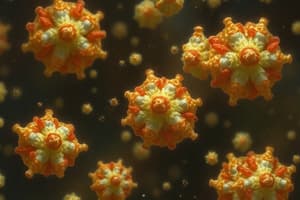Podcast
Questions and Answers
What are the principles of microbial contamination control?
What are the principles of microbial contamination control?
Control microbial contamination through quality assurance at all stages of the manufacturing process.
Which types of spoilage are mentioned?
Which types of spoilage are mentioned?
- Chemical
- Biological
- Physicochemical
- All of the above (correct)
What is spoilage in pharmaceuticals?
What is spoilage in pharmaceuticals?
Spoilage is the chemical and physicochemical degradation of pharmaceutical products rendering them unsuitable for use.
All packages used in hospitals are single-use only.
All packages used in hospitals are single-use only.
What microorganisms are commonly associated with contamination in pharmaceutical products?
What microorganisms are commonly associated with contamination in pharmaceutical products?
What must be done to water used in pharmaceutical manufacture?
What must be done to water used in pharmaceutical manufacture?
What can result from the growth of pathogenic microorganisms in a pharmaceutical product?
What can result from the growth of pathogenic microorganisms in a pharmaceutical product?
How can contamination from human sources occur?
How can contamination from human sources occur?
What type of environment is suggested to be high-risk for microbial contamination?
What type of environment is suggested to be high-risk for microbial contamination?
The contamination of a product can lead to ___ if not controlled.
The contamination of a product can lead to ___ if not controlled.
What are endotoxins and their effect on the human body?
What are endotoxins and their effect on the human body?
Flashcards are hidden until you start studying
Study Notes
Pharmaceutical Microbiology Overview
- The Pharm D program at New Mansoura University emphasizes the principles of microbial contamination and preservation in pharmaceutical products.
- Spoilage refers to the degradation of pharmaceutical products, resulting in efficacy and stability issues, leading to potential financial loss for manufacturers.
Types of Spoilage
- Chemical Spoilage: Deterioration of the drug's chemical nature and loss of potency.
- Physicochemical Spoilage: Changes such as turbidity, gas production, flavor alterations, and discoloration.
- Biological Spoilage: Infection risk from microorganisms like Clostridium tetani, Pseudomonas aeruginosa, and Salmonella, potentially causing severe health risks including febrile shock from endotoxins.
Sources of Contamination
- Emphasizes building microbial quality into products throughout the manufacturing process, rather than just at the end.
- Water: Must be treated (distillation, reverse osmosis, deionization) and stored above 80°C to prevent contamination.
- Environment: Wet sites (e.g., drains) harbor opportunist pathogens that may contaminate products.
- Packaging: Reused containers can introduce contaminants from hospital environments.
In-Use Contamination Sources
- Human Factors: Patients can contaminate products with their flora; nursing staff's hands may also transfer pathogens.
- Environmental Factors: Airborne contaminants can settle in open products, especially in warm conditions.
- Equipment: Reused applicators can lead to cross-contamination; emphasizes the need for disposable applicators.
Microbial Spoilage Indicators
- A pharmaceutical product is microbiologically spoiled if it shows:
- Low levels of pathogenic microorganisms.
- High levels of opportunist pathogens.
- Toxic microbial metabolites.
- Signs of degradation (e.g., viscosity changes).
Factors Leading to Spoilage
- Microorganisms use specific enzymes to degrade formulations, leading to physical breakdowns like emulsions cracking or separation of materials.
- Microbial susceptibility varies based on chemical structure and environmental conditions.
Specific Microbial Attacks
- Surfactants: Anionic surfactants are stable; non-ionic ones are metabolized easily.
- Thickening Agents: Substrates like starch and acacia are biodegradable; agar is resistant while gelatin is not.
- Humectants & Co-solvents: Glycerol and sorbitol can be metabolized effectively unless concentrated.
- Sweeteners: Sugars may lead to fermentation, altering product stability.
- Oils & Emulsions: Microbial growth occurs mainly in the aqueous phases of emulsions; moisture can promote spoilage.
- Active Ingredients: Enzymatic degradation of drugs such as penicillin and chloramphenicol is a significant concern.
Control and Preservation
- Fundamental to controlling microbial contamination is the selection and application of preservatives in pharmaceutical formulations.
- Evaluating the effectiveness of preservatives involves assessing their efficiency against microbial growth in pharmaceutical products.
Studying That Suits You
Use AI to generate personalized quizzes and flashcards to suit your learning preferences.




